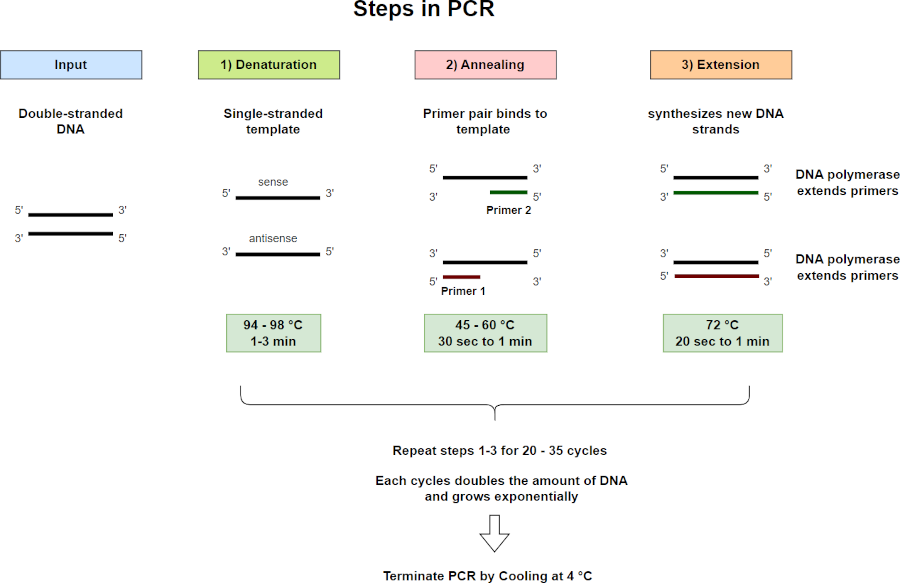Steps in PCR
Polymerase Chain Reaction (PCR) is a widely used molecular biology technique for in vitro amplification of a small DNA sequence. The PCR can be performed using the thermal cycler instrument. The PCR was developed by Kary Mullis (1983).
PCR is useful method for producing large amount of isolated DNA from small quantity DNA for molecular and genetic analyses. For example, PCR can be used for biomarkers identification in blood samples for detecting the presence of cancer.
There are three main steps in PCR,
- Denaturation: The double-stranded DNA denatured into single-stranded templates
- Annealing: Primer pairs bind to complementary sequences on the single-stranded DNA templates
- Extension: Synthesizes new DNA strands complementary to the single-stranded templates

Here is the detailed explanation of each PCR step,
Step 1: Denaturation
In this step, the double-stranded DNA is heated to a high temperature (94-98°C) to separate the double-stranded DNA into single-stranded DNA templates.
Note: If the starting material is RNA, the reverse transcription (using reverse transcriptase) should be performed to obtain double-stranded cDNA
The high temperature breaks the H bond and base stacking interactions between complementary base pairs in the DNA double helix.
The separated single-stranded DNA acts as templates for synthesizing a new strand of DNA during annealing and extension steps
The denaturation step is typically performed for 1 to 3 minutes. The high temperature or longer duration for denaturation may destroy the enzymatic activity of DNA polymerase and damage the DNA.
Step 2: Annealing
In this step, the temperature is lowered (45-60°C) and primer pairs (forward and reverse primers) bind (annealed) to the complementary sequences on single-stranded template DNA.
The annealing temperature should be ~5°C below the melting temperature (Tm) of the primers.
The optimal length and GC content of forward and reverse primers should be 15-30 nucleotide and 40-60%, respectively.
There are two primers, one for each single strand. The primer length should be 15-30 nucleotide
The annealing step is typically performed for 30 sec to 1 min.
Step 3: Extension
In this step, DNA polymerase (Taq polymerase) synthesizes new DNA strands, complementary to the templates, using primer-template complexes as a starting point.
Note: Taq polymerase is obtained from the bacterium Thermus aquaticus (Taq). It is heat stable and does not denature during the denaturation step.
DNA polymerase extends both primers simultaneously towards the 3’ end of primers and each PCR cycle doubles the amount of DNA.
This step is typically performed at 72°C for 20 sec to 1 min. The 1 min time is sufficient for smaller fragments (up to 2 Kbp). The extension step can be extended for larger fragments (1 min per kb).
Summary
This three-step (Denaturation, Annealing, and Extension) cycle is repeated 30-35 times for exponential amplification of the target DNA.
At the end of the reaction, the PCR amplification products (also known as amplicons) are analyzed using gel electrophoresis. The amplification products can be visualized directly by staining the gel with ethidium bromide.
This standard PCR is useful for detecting the target DNA but does not quantify the DNA. The quantification of DNA can be performed using the real-time quantitative PCR (qRT-PCR)
Enhance your skills with courses on genomics and bioinformatics
- Genomic Data Science Specialization
- Biology Meets Programming: Bioinformatics for Beginners
- Python for Genomic Data Science
- Bioinformatics Specialization
- Command Line Tools for Genomic Data Science
- Introduction to Genomic Technologies
This work is licensed under a Creative Commons Attribution 4.0 International License
Some of the links on this page may be affiliate links, which means we may get an affiliate commission on a valid purchase. The retailer will pay the commission at no additional cost to you.

